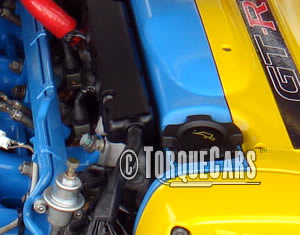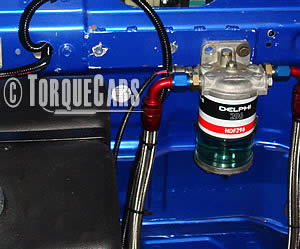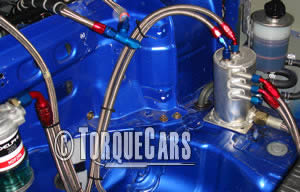Fuel systems
"A car with a drink problem!"

Cars need a precise mix of oxygen and fuel to burn effectively. Much of the engine tuning done by TorqueCars members involves increasing the cars capacity to burn the air and fuel mix. Much attention is generally given to the air intake and we have discussed the various aspects of forced induction.
We should not overlook the fuelling as it is essential to keep the mix right. Power is lost when the engine adjusts itself to stop it running too rich or lean. Many power losses at certain points in the rev band can often be traced to a fuelling issue.
Components of a fuel system
- Fuel pump - This is the essential and sucks the fuel from the tank piping it to the injectors.
- regulator valve - This adjusts the amount of pressure in the fuel system and directly relates to the throttle (accelerator) position. More throttle requires more fuel.
- Injectors - these squirt the fuel as a fine mist allowing it to mix with the intake air charge.
- Intake manifold - This is where the fuel mixes with the air before entering the cylinders. (Although manufacturers are now perfecting direct injection where fuel is sprayed directly into the cylinders.
- Return pipes - Excess fuel is returned to the tank. This process is carefully controlled and ensures that irregular pressure fluctuations do not happen.
So what can go wrong?

If the fuel pump is too weak the engine will lose fuel pressure at high revs. Fitting additional fuel pumps or larger fuel pumps will help to ensure a good delivery of fuel at the engine. Some cars experience starvation on long bends where the fuel pick up is on one side of the tank. If the tank is running low the fuel will flow to the other side of the tank causing the pickup to run dry. This was noted on some early Subaru Imprezas although most will now have an uprated fuel pick up to address this issue.
Regulator valves are not known for their speed or smooth operation, especially when they get old. Fitting an uprated fuel pressure valve will greatly improve throttle response. Owners report a much snappier response when they put their foot down and problems such as surging and hesitancy in traffic are also improved.
Some drivers also report more top end power although theoretically the amount of fuel delivered is the same. This could be attributable to the improvement over a standard sticking hesitant fuel valve though.
Over time the injectors will clog up. This will reduce their ability to create a fine mist or fuel which mixes easily with the air. Instead a dribble of fuel is delivered which is then only partially burnt.
A fuel injector cleaner used regularly can really help to keep them operating at peak efficiency and TorqueCars fully endorse the Redex range of products. Injectors are rated by cc - the amount of fuel they deliver. When substantially increasing engine power it becomes imperative to uprate the injectors. Look to other models in your manufacturers range for suitable uprated parts. A turbo charge 1.6l engine will easily require as much fuel as a naturally aspirated 2.0 engine.
Manifold shape is critical. The grooves and bumps on the surface provide more area to aid the evaporation of fuel into the intake charge mixture. For this reason you should avoid the temptation to polish the intake manifold, concentrate instead on the head of the engine and exhaust outlet if you have an overwhelming need to polish something.

Return pipes can get clogged up. This can cause all manner of problems in the fuelling and generally cause surges and make the engine run too rich. All fuel lines should be inspected and renewed if they show signs of fatigue.
When increasing the fuel pressure the fuel lines are typically the first thing to go. If they are not in perfect condition the extra pressure will highlight the weakspots and cause a leak. Air locks in the fuel lines are very undesirable and pumps can burn out or fuel starvation can happen. Never run a car with fuel injection on empty, the damage and incovenience caused is really not worth it.
If you liked this page please share it with your friends, drop a link to it in your favourite forum or use the bookmarking options to save it to your social media profile.
Check out TorqueCars new YouTube channel, and see their awesome new content...
Feedback
Please use our forums if you wish to ask a tuning question, and please note we do not sell parts or services, we are just an online magazine.
Help us improve, leave a suggestion or tip
